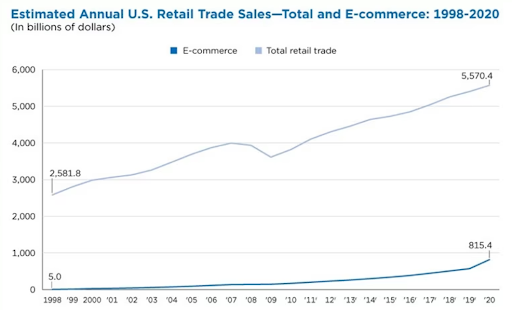The eCommerce landscape has been evolving at an unprecedented pace. The convenience of online shopping, especially during the COVID-19 pandemic, has driven substantial growth in the eCommerce industry. According to data from Census, eCommerce sales increased by 43% from $571.2 billion in 2019 to $815.4 billion in 2020. As a result, competition has intensified, and eCommerce businesses are seeking innovative ways to stand out in the crowded marketplace. One such strategy that has gained immense popularity is marketing automation. Marketing automation has emerged as a powerful tool for eCommerce businesses to streamline their marketing efforts, engage with customers more effectively, and drive revenue. However, the success of marketing automation in eCommerce depends on how well it’s executed and measured. In this article, we will explore the essential metrics for eCommerce stores to improve visibility with their marketing automation efforts. But first, let’s understand the role and importance of marketing automation in eCommerce. Marketing automation refers to using software and marketing tools to automate repetitive marketing tasks and workflows. It enables eCommerce businesses to deliver personalized information to their customers across various channels like email, SMS, social media, and websites. Benefits of Marketing Automation in eCommerce include:
Now let’s dive into the key metrics that businesses should keep an eye on for successful marketing automation: The conversion rate is a fundamental metric for your business. It measures the percentage of visitors who take a desired action such as making a purchase, signing up for a newsletter, or downloading an eBook. You can boost the conversion rate by improving your checkout flow & streamlining the login experience. In the context of marketing automation, it’s essential to track how automation efforts impact your conversion rate. To evaluate its effectiveness, track conversion rates across various channels such as your website, email campaigns, social media, and others. Identify which channels perform best and focus your automation efforts accordingly. Customer Acquisition Cost (CAC) is the cost associated with acquiring a new customer. While marketing automation can reduce manual labor costs, it’s crucial to analyze how much you’re spending on automation tools and campaigns compared to the number of new customers gained. To calculate the same, divide the total marketing and sales expenses by the number of new customers acquired within a specific timeframe. This metric helps you assess the efficiency of your marketing automation in driving eCommerce sales and acquiring customers at cost-effective rates. Customer Lifetime Value (CLV) measures the total revenue a customer is expected to generate over their entire relationship with your eCommerce business. It’s a crucial metric because it assesses the long-term impact of your marketing automation efforts. CLV calculations should consider not only the initial purchase but also the potential for repeat purchases and customer retention. Marketing automation can play a significant role in nurturing customer relationships and increasing CLV. Abandoned carts represent missed revenue opportunities. Marketing automation can help recover some of these abandoned carts by sending automated reminders and incentives to customers who leave products in their carts without completing the purchase. You can measure the success of your abandoned cart recovery automation by tracking the percentage of abandoned carts that are eventually converted into purchases. Analyze the effectiveness of your recovery emails and make adjustments as needed. Email marketing automation is a cornerstone of your eCommerce marketing strategies. Open and click-through rates (CTR) are essential metrics for evaluating the performance of your automated email campaigns. Monitor the open and CTRs of your automated email campaigns to assess their engagement levels. Low open rates may indicate issues with subject lines or sender reputation, while low CTRs could signal problems with email content or calls to action. In addition to conversion-related metrics, it’s essential to monitor customer engagement metrics. These include the average time spent on your site, the number of page views, and bounce rates. Using a flipbook maker can help you create interactive content that keeps visitors engaged longer. Engagement metrics provide insights into how effectively your website and automation workflows are engaging visitors. Use this data to refine your automation strategies and create more engaging content and user experiences. The churn rate measures the percentage of customers who stop doing business with your eCommerce brand during a specific period. High churn rates can have a significant negative impact on revenue. Analyze automation data to identify the causes of churn. Are customers unsubscribing from your emails? Are they abandoning their accounts? Understanding the reasons behind churn can help you develop targeted automation strategies to reduce it. Return on Investment (ROI) measures the financial return on your marketing automation investments. It’s one of the most crucial metrics to ensure that your automation efforts are generating a positive impact on your bottom line. When calculating ROI, consider not only the direct revenue generated but also the indirect benefits, such as improved brand reputation, increased customer loyalty, and cost savings from automation. Social media plays a vital role in eCommerce marketing, and engagement metrics help assess the impact of your automation efforts on social platforms. These metrics include likes, shares, comments, and follower growth. Automate your social media posting to maintain a consistent online presence. Using social media management tools, you can schedule posts strategically to reach your audience when they are most active. After you’ve prepared a calendar, track engagement metrics on platforms like Facebook, Instagram, Twitter, and LinkedIn. Analyze which types of content and posting schedules generate the most engagement and refind your strategy. Average Order Value (AOV) measures the average amount customers spend in a single transaction. It’s a one of the valuable metrics as it directly impacts revenue and profitability from your marketing automation efforts. You can send automated upsell and cross-sell recommendations through your email marketing tools and run campaigns. To calculate AOV, divide the total revenue by the number of orders within a specific period. Marketing automation can influence AOV by suggesting upsells, cross-sells, and personalized product recommendations. While acquiring new customers is essential, retaining existing ones is equally important. Customer Retention Rate measures the percentage of customers who continue to do business with your online store over time. You can implement automation in loyalty programs, sending personalized emails, and gathering customer feedback to improve customer retention. To calculate the retention rate, divide the number of customers at the end of a period by the number of customers at the beginning of that period. A high retention rate indicates that your marketing automation efforts are effectively nurturing and retaining customers. Refund and return rates measure the percentage of products that customers return or request refunds for. While not always seen as a positive metric, it’s essential to monitor these rates as they impact customer satisfaction and operational efficiency. Divide the number of refunded or returned products by the total number of products sold within a specific period. Marketing automation can help reduce refund and return rates by providing post-purchase support and addressing customer concerns proactively. Marketing automation has become indispensable for eCommerce businesses looking to stay competitive and drive growth. To ensure the success of your marketing automation efforts, it’s crucial to measure and analyze key metrics regularly. By tracking the above-mentioned metrics, you can optimize your automation strategies and continually improve your business’s performance. Remember that automation is not a static process; it requires ongoing monitoring, testing, and refinement to achieve sustained success in the dynamic eCommerce landscape. Chirag Bhavsar is founder of Coduzion. He is Gusty, Passionate, and a Sports freak. Loves to spend time reading financial books and playing outdoor games as soon as he is away from his desk. He always loves to take on new challenges and get good at them
Role & Importance of Marketing Automation in eCommerce
Key Metrics to Keep an Eye on for Marketing Automation Success
1. Conversion Rate
2. Customer Acquisition Cost
3. Customer Lifetime Value
4. Abandoned Cart Recovery
5. Email & Click-through Rate
6. Customer Engagement Metrics
7. Ecommerce Churn Rate
8. Return on Investment
9. Social Media Engagement
10. Average Order Value
11. Customer Retention Rate
12. Refund and Return Rate
Conclusion
Don’t forget to share this article
